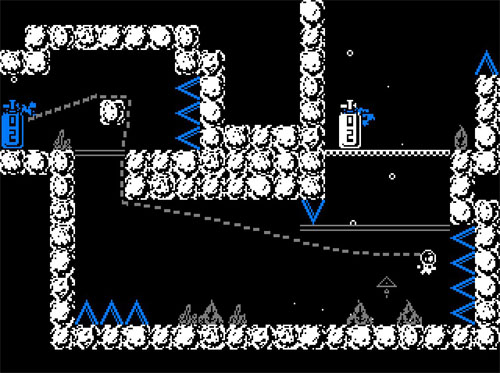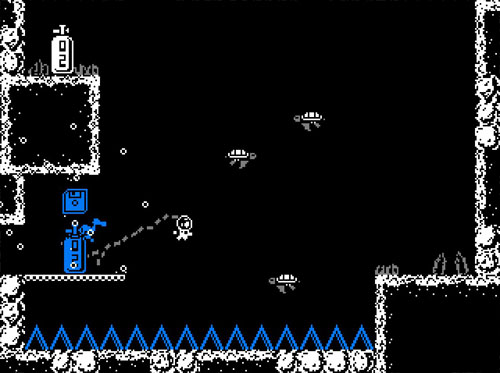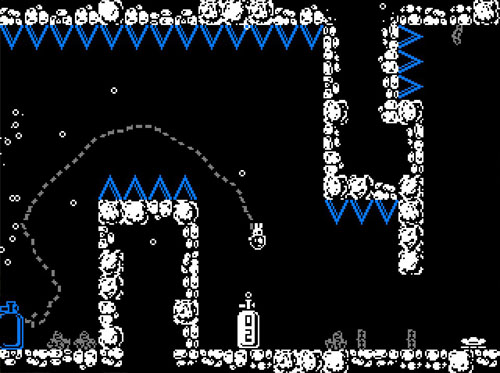A game by Ismael Rodriguez for PC, originally released in 2021.
Below the Ocean is a subaquatic puzzle-platformer centered around discovering four ancient treasures deep beneath the ocean’s depths. You take on the role of an explorer who drops to the ocean floor using a diving bell, and then dons a pressure suit to explore his surroundings… all the while tied to a tether that feeds oxygen to his suit. Many dangers await, in the form of hostile sea creatures, genre staple spikes, mysterious technology, and a nasty death by suffocation should he take too many risks.The game is divided into four areas, all of which are accessible from the start, and each area begins with a diving bell sequence, during which time the diver ruminates over the stories he has heard throughout his life of great treasures, strange secrets, and places that exist below the water itself. And each time, he repeats the phrase, “This abyss is my destiny.” Each area represents a single descent to find one of four treasures: The Queen's Pearl, The Cardinal's Grail, The Nobleman's Crest, and The Soldier's Spade.
As is common in puzzle-platformers, controls are simple, but the ways in which you use your abilities become more complex as the game goes on. To start, you have slow movement and a floaty jump, due to the fact that you are moving underwater, and you have the ability to wall jump along most surfaces. Grabbing a bubble gives you a one-time double jump – after which the bubble pops – and there are different kinds of bubbles to be found later in the game (more on this in a bit). When inside a bubble, you are pushed along by air currents, often allowing you to reach higher areas, but sometimes pushing you toward danger, requiring you to pop the bubble before you are killed.
What makes this game truly unique as a puzzle platformer is the air hose that tethers you back to a nearby oxygen tank. First of all, the tether limits your movement to a short range, often (but not always) extending about two-thirds of the width of the screen. This limited range is the basis for most puzzles as the only way to continue moving forward is to reach another oxygen tank, thereby giving you a new tether point. Oxygen tanks also act as checkpoints.
Secondly, when you reach the full length of your tether, you are tugged backward with a small amount of elasticity. More importantly, when pressing in the opposite direction of the tether, you can swing yourself upward, allowing you to reach higher platforms, switches, and new oxygen tanks. Sometimes you need to wrap your tether around a block to shorten its range. There are a variety of ways you can wrap the tether around blocks to reach new platforms, hang off of ledges, or even swing yourself to distant points.
Puzzle solutions are generally apparent or may be discovered through a bit of experimentation, so puzzle platforming veterans can expect to make it through the game fairly quickly. However, there’s a secondary challenge in the form of diamonds that are spread throughout the four areas. Collecting all of these diamonds is more difficult and often requires the use of advanced techniques. Similar to the strawberries in Celeste, diamonds don’t count as being collected until you reach a safe area, which in this case is the next oxygen tank checkpoint. Reaching the end of each area displays a summary showing your completion time, number of deaths, and number of diamonds collected.
Things start out simply enough in the opening area, with the player primarily tasked with moving from one oxygen tank to the next as he learns the controls for wall jumping, swinging on the tether, and using bubbles to double jump (bubble jump?). Diamonds in the first area are placed generally along the player’s path, and these are not too difficult to collect. Toward the end of the area, the player encounters yellow blocks that imbue the tether and the diver with electricity. The player must wrap his tether around these energy blocks, activate a switch to open the door to the exit, and then unwind the tether to actually leave the room.
The second area introduces new gameplay concepts more quickly than the first, requiring players to make use of more complex techniques, but these all build off of one another, creating a sudden yet smooth difficulty curve. The first new gameplay element comes in the form of small oxygen tanks that merely extend the total length of the player’s tether, and these do not act as checkpoints. Here, the player must string together multiple successful movements to move between several oxygen tanks and reach the exit. Notably, tethers from these small tanks tend to be shorter, allowing the player less freedom of movement. Reaching large oxygen tanks breaks all of the previous tethers and grants the player a new one, just as in the first area.
The player also encounters sea life in this area, including turtles that can be used as springboards, hermit crabs that can be kicked around, and blue crabs that will kill him if he touches them. From this point forward, any blue lifeforms are deadly to the player.
This area also introduces blue bubbles. Instead of simply allowing for a double jump, these allow the player to move in any direction for a couple of seconds, allowing for quick jets upward, at angles, or across gaps. These bubbles are also pushed along by air currents, allowing for more complex sequences where the player must allow himself to be pushed in one direction before quickly making use of his multi-directional speed boost.
At the end of the first area, the player drops into an area below the water. Here, he runs around unencumbered by a tether or the need for oxygen, but while his movement speed is greatly increased, his jump height is tiny and he cannot wall jump or use bubbles. In the second area, new elements are introduced where the player enters air pockets that work in the same way, but things quickly become more complex when he encounters tether tie-offs that aren’t oxygen tanks. From these points, the player has 10 seconds to reach an air pocket or another oxygen tank before he is killed.
This area also introduces springboards that launch you into the air, tether tie-offs that let you fire yourself in a chosen direction like a slingshot, smooth surfaces where you can’t wall jump, and the ability to kill enemies by electrifying your tether. Future areas don’t pile on quite so many new gameplay elements in such a short span.
The third area introduces yellow angular bits that must be collected in sets of four in order to activate tether tie-offs (again giving you 10 seconds to get to safety). There are also launchers that send you along in a given direction and claws that reach out to grab you and connect you to new oxygen tanks. The biggest gameplay change comes in the form of clear tanks (helium tanks?) that allow you to jump between the floor and the ceiling and build up momentum to break rock walls.
The final area introduces electrified bubbles that let you speed along in a given direction, just like the blue bubbles, and this can be used to stretch your tether further. If you kill an enemy while electrified – or hit certain designated nodes – your charge is restored, leading to sequences where you must quickly zip between multiple targets to stay aloft. There are also some speed-based sequences where you must outrun rows of falling spikes. Unfortunately, there is no ending upon completing the fourth and final area, and you are simply returned to the area select interface, just as you are when completing any other area.
Visually, the game is presented with chunky low-rez sprites and a very limited color palette consisting of white, grey, blue, and yellow, with black as the background color. The game is accompanied by low tempo music that fits well with the underwater theme. There isn’t any kind of narrative to tie the experience together, outside of the vague (and grammatically problematic) monologues that introduce each area. Nothing more is made of the mysterious treasures nor the area that exists below the ocean’s water.
2D CRED
Below the Ocean was developed by Ismael Rodriguez, who is based in Connecticut. The game was originally developed for Ludum Dare 48, which had a theme of “deeper and deeper”, and essentially consisted of this game’s first area. Three new areas were added to expand the game into a more complete experience. This was Ismael’s first retail release.



























0 comments:
Post a Comment